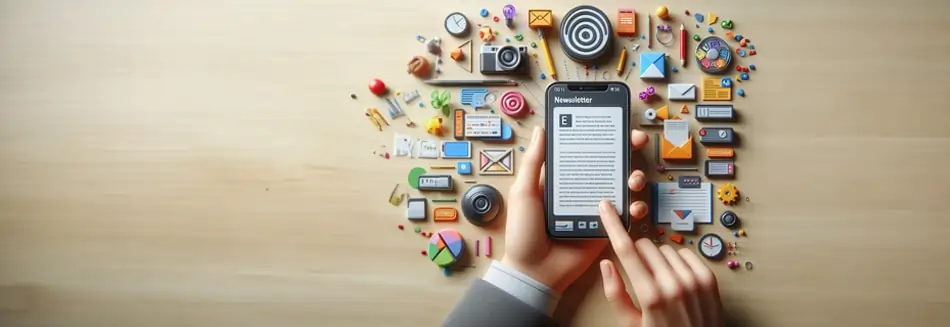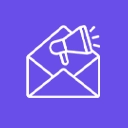An email newsletter is a powerful engagement tool. Bearing in mind that this material focuses on the people who have chosen to receive it, you can already imagine the extent of its relevance, not only for your company, but also for the public.
All communication in a newsletter should stimulate interaction with the public in a natural and spontaneous way. And this interaction is intended to promote the brand’s relationship with the user.
In other words, a well-designed email newsletter is part of something bigger; a content plan designed to delight and involve the consumer.
See valuable tips on how to turn a newsletter into a marketing strategy by watching the exclusive webinar on this subject!
The importance of email validation
The great thing about the newsletter is that the user has subscribed. In other words, they have allowed you to receive this communication in their inbox.
In this way, the email newsletter subscriber is a valid email address that you have in your hands. And valid emails are worth gold to anyone who communicates via email marketing.
However, a valid email can become invalid (also known as a bounce) at any time, for various reasons. Here are some of them:
- Corporate emails that change ownership – turnover in companies makes emails obsolete.
- Disposable addresses, created to work only for a few hours or days.
- Emails that don’t engage (when users don’t send messages or click on anything).
- A domain that stops working.
Email validation removes invalid emails from lists, guaranteeing a sanitized base capable of generating real opportunities for sales teams.
Hence the importance of checking your bases frequently. In principle, the user who has consented to receive your email newsletter is a valid email address, but you don’t know until when.
A well-designed newsletter involves the reader and requires the use of elements that generate a connection. When this happens, the brand gets closer to the consumer, creating experiences that lead them to respond to the communication stimuli.
Sending newsletters is a relationship marketing tactic, which was created to strengthen the bond between customer and brand. Let’s see how it can help with loyalty strategies.
What is relationship marketing?
Relationship marketing is a set of strategies whose purpose is to get closer to customers. And the first step in doing so is to identify the persona, their habits and pains.
When you know your audience well, it’s easier to engage with them through a newsletter, isn’t it?
The relationship with the customer begins at the stage of capturing leads, and the intention is for it to always evolve, resulting in loyalty.
In other words, a contact who is at the top of the funnel must be worked on to become a recurring consumer.
And this result is only possible through relationships. That’s where the email newsletter comes in, fulfilling its role of creating and maintaining contact with the customer.
All of this is deeply linked to Inbound Marketing, or Attraction Marketing, which has the principle of delighting customers, with the aim of making them promoters of your brand.
If a consumer recommends your brand, it’s a sign that the relationship and loyalty work has generated good results.
The ideal frequency of an email newsletter
Each email newsletter communication should accompany the pains and desires of your persona.
This means that there is no standard frequency, although almost half of professionals opt to send one newsletter a week (46.19% in 2023 against 45.79% in 2022), to avoid the unsubscribe button. The data comes from GetResponse.
In short, watch out for the possibility of subscriber overload. If it’s a very large newsletter, split it into two and send two emails a week.
How to create a high-converting email newsletter
Interactive content invites the reader to take part in an experience that goes beyond simply reading the information in the newsletter.
Here are some examples of how to add interaction and make your newsletters more attractive:
- Ask the user to give their opinion on the newsletter by clicking on excellent | good | fair | poor.
- Insert interactive infographics, with options for the public to click and discover videos, animations, etc.
- Create tables of contents with related links, so that readers can go directly to the content that interests them.
- Include a countdown timer if it makes sense with the newsletter’s communication.
Photos that change angle when the user clicks, playful content that suggests games, etc. The possibilities are endless, and imagination and budget are the limit. Explore what you can to make your newsletter stand out and generate more conversions.
What not to do in an email newsletter
It’s always good to remember the subject line and the preheader. These tips apply to all types of emails, including email newsletters.
An effective subject line should not exceed 50 characters, so that it is fully viewable on desktops, cell phones and tablets.
The preheader (that bit of text that follows the subject line) should be no longer than 55 characters.
The ideal dimensions of an email newsletter are 600 pixels wide, so that the user doesn’t have to access the space bar to view the entire layout.
The size of the images is very important, as failure to do so can lead to your newsletter being sent to the spam folder.
Email providers have set 500kb as the maximum weight for images in an email. Therefore, use Jpeg, animated Gif and PNG compressions to make your newsletter lightweight.
FAQ
Why is it important to include the email newsletter in marketing strategies?
The newsletter promotes the engagement of an audience that is already interested in communicating with the sender of the message. As such, this piece of communication has great power to build customer loyalty and create a relationship with them.
When well-designed, an email newsletter is an integral part of a content plan designed to delight the reader and make them a brand promoter.
Why check email newsletter subscribers’ lists, since they have allowed it to be sent?
Contacts from email newsletters indicate valid emails. However, these addresses can become invalid at any time, for various reasons. That’s why frequent email validation is so important.
What is not recommended when writing an email newsletter?
Subject lines and preheaders over 50 and 55 characters respectively, heavy images and dimensions over 600 pixels wide are elements that can ruin the communication of a newsletter.



